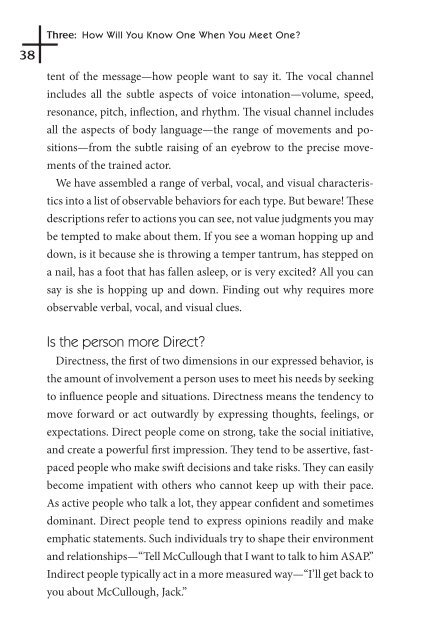PeopleSmart in Business eBook - The Platinum Rule
PeopleSmart in Business eBook - The Platinum Rule
PeopleSmart in Business eBook - The Platinum Rule
Create successful ePaper yourself
Turn your PDF publications into a flip-book with our unique Google optimized e-Paper software.
38<br />
Three: How Will You Know One When You Meet One?<br />
tent of the message—how people want to say it. Th e vocal channel<br />
<strong>in</strong>cludes all the subtle aspects of voice <strong>in</strong>tonation—volume, speed,<br />
resonance, pitch, <strong>in</strong>fl ection, and rhythm. Th e visual channel <strong>in</strong>cludes<br />
all the aspects of body language—the range of movements and positions—from<br />
the subtle rais<strong>in</strong>g of an eyebrow to the precise movements<br />
of the tra<strong>in</strong>ed actor.<br />
We have assembled a range of verbal, vocal, and visual characteristics<br />
<strong>in</strong>to a list of observable behaviors for each type. But beware! Th ese<br />
descriptions refer to actions you can see, not value judgments you may<br />
be tempted to make about them. If you see a woman hopp<strong>in</strong>g up and<br />
down, is it because she is throw<strong>in</strong>g a temper tantrum, has stepped on<br />
a nail, has a foot that has fallen asleep, or is very excited? All you can<br />
say is she is hopp<strong>in</strong>g up and down. F<strong>in</strong>d<strong>in</strong>g out why requires more<br />
observable verbal, vocal, and visual clues.<br />
Is the person more Direct?<br />
Directness, the fi rst of two dimensions <strong>in</strong> our expressed behavior, is<br />
the amount of <strong>in</strong>volvement a person uses to meet his needs by seek<strong>in</strong>g<br />
to <strong>in</strong>fl uence people and situations. Directness means the tendency to<br />
move forward or act outwardly by express<strong>in</strong>g thoughts, feel<strong>in</strong>gs, or<br />
expectations. Direct people come on strong, take the social <strong>in</strong>itiative,<br />
and create a powerful fi rst impression. Th ey tend to be assertive, fastpaced<br />
people who make swift decisions and take risks. Th ey can easily<br />
become impatient with others who cannot keep up with their pace.<br />
As active people who talk a lot, they appear confi dent and sometimes<br />
dom<strong>in</strong>ant. Direct people tend to express op<strong>in</strong>ions readily and make<br />
emphatic statements. Such <strong>in</strong>dividuals try to shape their environment<br />
and relationships—“Tell McCullough that I want to talk to him ASAP.”<br />
Indirect people typically act <strong>in</strong> a more measured way—“I’ll get back to<br />
you about McCullough, Jack.”


